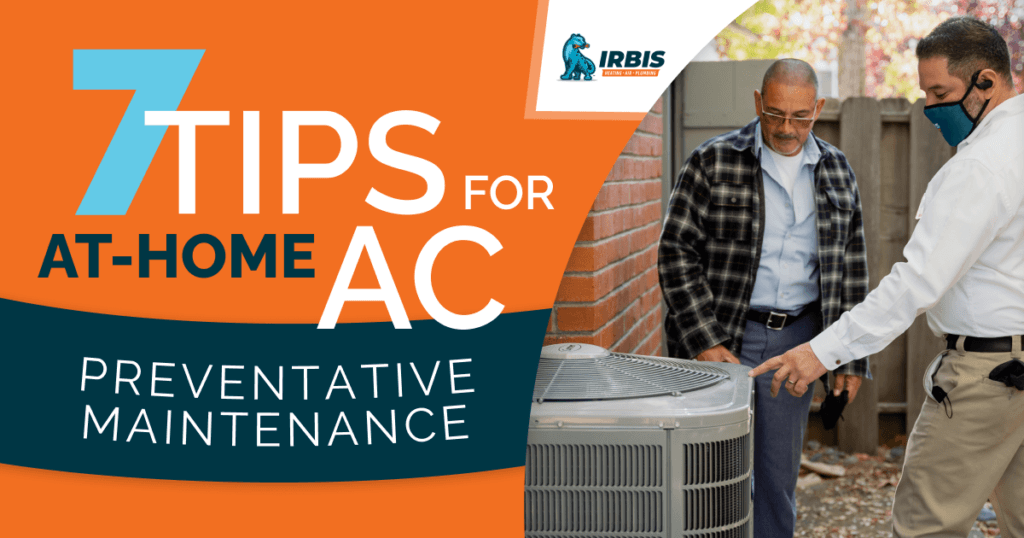
Home air conditioning systems have several components, each with many working parts. Every component must work smoothly and in tandem. Scheduling annual AC maintenance is crucial for this to happen. But there are many AC preventative maintenance tasks you don’t need a technician for. These seven tips can help improve system performance, efficiency, and longevity and save you in the long run.
Improve Your Air Conditioning Performance
1. Change the Indoor Air Filter
A clogged filter can block airflow, which can reduce comfort and strain the system. Inspect your air filters for dust and dirt at least every month. Change the filter when it is clogged. Any HVAC air filter should be changed at least every three months.
Also, change the blower filter twice a year. Ideally, this is done just before the cooling season and just before the heating season. When changing a filter, the new one should match its physical size and airflow rating.
2. Check Thermostat Function
The thermostat reads the ambient temperature of a space and sends signals to your air conditioner. If it’s not working properly, your AC may not turn on and off when it should. A unit that runs at the wrong times can be strained or use more energy than necessary.
To clean the thermostat, remove the cover and dust the inner parts with a soft brush. Replace the batteries and check for loose or corroded wires. If all looks well, replace the cover.
If the system isn’t running properly, check the switch. The thermostat should be set to “Cool” mode for the AC to cool your home. If it’s set to “heat” or “Off”, change the setting. Also, check the programmable settings and adjust them if necessary. If they change on their own, there may be an electrical glitch.
3. Check Electrical Connections
Inspect all the system’s electrical connections. If any are loose or disconnected, tighten them. Outdoor units are especially vulnerable. Connections can loosen due to the elements or small animals can move them or chew through wires. If any wires are damaged, call for repairs.
All connections must be tight for the system to work properly. This includes connections to the breaker panel; the system uses a lot of electricity and a breaker connection is a must in case the system overloads. Therefore, at-home AC preventative maintenance can avoid a lot of headaches and hazards.
4. Clean the Outdoor Unit
The condenser unit is one of an AC system’s most important parts. And since it’s outside, it is susceptible to issues. The copper tubes in the condenser provide a path for the refrigerant and are where heat transfer occurs so that an AC can cool your home. To start, turn the unit off at its power switch and the circuit breaker. You can now safely open the unit. Then proceed with these steps:
- Clear debris at least two feet around the unit.
- Brush dirt and debris from the condenser fins.
- Use a vacuum cleaner with a brush attachment for finer debris.
- Straighten bent fins with a dull dinner knife or a fin straightening tool.
- Spray the fins clean with a garden hose.
- Clear leaves from the fan; wipe it with a damp cloth.
- Lubricate the fan motor with a few drops of electric motor oil.
5. Lubricate Moving Parts
Extensive wear and tear can result if moving parts aren’t properly lubricated. Aside from lubricating the fan motor, open the oil ports and add a small amount of oil to each. With this type of AC preventative maintenance, we recommend using an oil container with a small hose or nozzle. Stop pouring once the oil starts to spill from the port. Use a rag to wipe any spilled oil and close the ports.
6. Clean the Evaporator Coil
Next, move on to the indoor unit. Access the evaporator coil inside it and check for dust and debris. Use a soft brush to remove dirt. Then spray the area with a no-rinse coil cleaner to get deposits off the coil. For stubborn dirt, you can use mild detergent and water.
7. Check the Evaporator Drain
A drain eliminates condensation that forms as your AC removes moisture from the air. In the process, it can clog with mold or algae. If there’s a drain float, the AC unit will stop working when the drain backs up.
First, check the drain pan for standing water or any damage. Then look for blockages in the drain that can cause flooding. To check the drain line, look for an inch-wide PVC pipe that leads from the indoor evaporator to a drainage point near the condenser unit. Debris can often be removed using a wet/dry vacuum. Call a professional to resolve more serious blockages.
Call IRBIS to Schedule AC Preventative Maintenance
Preventative maintenance can avoid an AC breakdown and major repairs. You’ll also spend less on energy bills. And your HVAC system can operate more safely without electrical or indoor air quality issues. It can also last longer as one neglected component doesn’t malfunction and cause others to fail.
At IRBIS, our licensed technicians perform AC inspections and tune-ups that require following a detailed checklist. To schedule AC maintenance in the South Bay Region, call (669) 322-8182 today.

